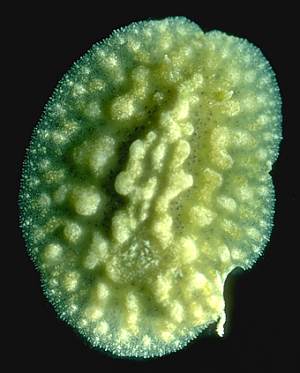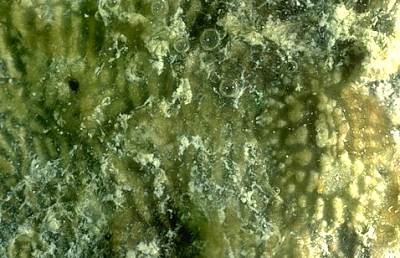

Asteronotus mimeticus
Gosliner & Valdes, 2002
Order: NUDIBRANCHIA
Suborder: DORIDINA
Superfamily: EUDORIDOIDEA
Family: Dorididae
DISTRIBUTION
Known from several localities in the western Pacific Ocean from the Philippine Islands, Palau, Indonesia, Australia and Papua New Guinea.
PHOTO
Lizard Is, North Queensland, Australia, 100m off Research Lab on patch reef, 3m, on Carteriospongia, 1 June 1979, AM C115955, 21 mm long alive. In lower photo animal is on right side of the photo on its food sponge, Carteriospongia. PHOTO: W.B.Rudman.
Animals are oval in shape with a gray, brown or yellow body. Notum has scattered opaque white spots and may be entirely smooth or possess tubercles and a few elongate papillae. Rhinophores are perfoliate wth 6-10 lamellae, some specimens with a brownish pigment on the base and middle region. The apex being an opaque white.Seven to eight lobes are evident along the margin of the rhinophoral sheaths. The gill consists of 5-6 tripinnate branchial leaves possibly with scattered opaque white spots and are coloured similarly to the body.Six distinct lobes are contained within the gill pocket. The broad foot is the same colour as the rest of the body and is bilabiate and notched anteriorly. An elongate, digitiform oral tentacle is present on either side of the labial region and mouth.
Found abundantly on the underside of sponges such as Phyllospongia lamellosa and Carteriospongia. Egg mass is a flat tightly coiled spiral of 2-3 whorls with relatively large eggs suggesting direct or lecithotrophic development.
See also Asteronotus spongicolus.
Reference:
• Gosliner, T.M. & Valdes, A. (2002) Sponging off of Porifera: New species of cryptic dorid nudibranchs (Mollusca: Nudibranchia)from the tropical Indo-Pacific. Proceedings of the California Academy of Sciences, 53(5): 51-61.
Rudman, W.B., 2003 (January 15) Asteronotus mimeticus Gosliner & Valdes, 2002. [In] Sea Slug Forum. Australian Museum, Sydney. Available from http://www.seaslugforum.net/find/astemime
Related messages
Asteronotus mimeticus from Lizard Is, north Queensland
January 20, 2003
From: Bill Rudman


In a separate message I note the discovery of two new remarkable dorid mimics. Here is a photograph of one of them, Asterononotus mimeticus, from north Queensland, Australia.
Data: Lizard Is, North Queensland, Australia, 100m off Research Lab on patch reef, 3m, on Carteriospongia, 1 June 1979, AM C115955, 21 mm long alive, PHOTO: W.B.Rudman.
Rudman, W.B., 2003 (Jan 20) Asteronotus mimeticus from Lizard Is, north Queensland. [Message in] Sea Slug Forum. Australian Museum, Sydney. Available from http://www.seaslugforum.net/find/8933Two new cryptic species of Asteronotus
January 20, 2003
From: Bill Rudman
Two new species of Asteronotus have been described in a recent paper by Gosliner and Valdes (2002). These two species, Asteronotus mimeticus and Asteronotus spongicolus are two more of the remarkably cryptic species we find associated with particular sponges in the tropical Indo-Pacific. In separate messages I have posted photos of them from the Great Barrier Reef. How I came to take the photos illustrates just how well these animals can camouflage themselves.
On a trip to the Australian Museum's field station at Lizard Island I was handed this strange dorid by a visiting sponge expert, Dr G. Bakus, who said he had found it on a cup sponge, Carteriospongia sp. The next day, Ian Loch, who was with me from the Museum, went looking for a colony of Carteriospongia so we could check the sponge's identity and take some photos. Ian found the correct sponge, so I put it in an aquarium with the dorid for photographing the next day. However, when I came to photograph the slug, I couldn't find it, despite diligently searching all over the sponge. Finally in desperation I started to rip the sponge into strips, hoping to find the animal that way. I finally had success, but surprisingly the slug I found was a distinctly different one which we hadn't seen on the sponge the day before. Finally I also found the original one, extremely well-hidden on the remains of the sponge, and I was able to photograph them both. I have waited for years in the hope of finding more specimens of these two amazing species. From Gosliner & Valdes's paper it seems they are widespread in the Indo-West Pacific, but it seems that their excellent camouflage has ensured that they have seldom been seen.
• Gosliner, T.M. & Valdes, A. (2002). Sponging off of Porifera: new species of cryptic dorid nudibranchs (Mollusca, Nudibranchia) from the Tropical Indo-Pacific. Proceedings of the California Academy of Sciences 53(5): 51-61.
Best wishes,
Bill Rudman
billr@seaslugforum.net
Rudman, W.B., 2003 (Jan 20) Two new cryptic species of Asteronotus. [Message in] Sea Slug Forum. Australian Museum, Sydney. Available from http://www.seaslugforum.net/find/8936